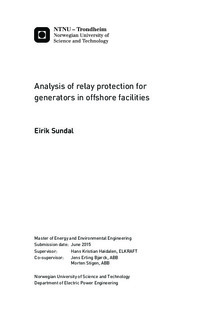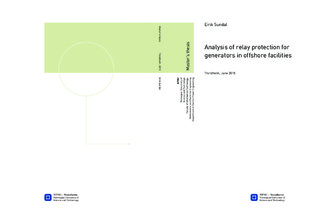| dc.description.abstract | This thesis study how to configure protective relays for protection of generators in offshore
oil and gas facilities. On the Norwegian continental shelf, most platforms have isolated
power systems with local power generation by a few synchronous generators. Normally,
these generators have very similar ratings, also from facility to facility. Due to the natural inherent safety hazards of operating an electrical system in offshore oil and gas facilities, special standards regulate the practice. This applies especially to relay protection of generators because of its essential role for the facility operation combined with its wide range of failure mechanisms. In addition, the electrical system design is also very similar between facilities. All this, makes it possible to find a standard setup for protective relays that are used in such facilities.
The thesis identify present standards and regulations that applies to generator protection
in these facilities. The underlying reasons for these are also explained. Based on this,
the thesis propose functions in the ABB REG670 relay that can be used as a standard
solution for all generators in such facilities, to achieve optimal generator protection and
full compliance with existing requirements.
Relay setting tables for generators in five different facilities is studied to identify how
relay protection for generators in these facilities is performed today. Based on this work,
the thesis guide how to configure the proposed relay functions. In addition, function
parameters that can be set equal for all generators are identified.
A study of short-circuits in the power system external to the generator zone is performed.
This identifies current contributions from a single generator for different fault
types and system configurations. The study showed that a generator relay is not able to
detect short circuits on other buses than where it is connected. On this bus, the current
contribution from a single generator is unaffected by other equipment connected to the
bus. This prove that it is not necessary to perform such a study when upgrading the
generator relay. | |

